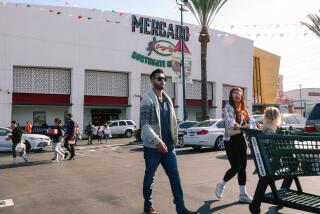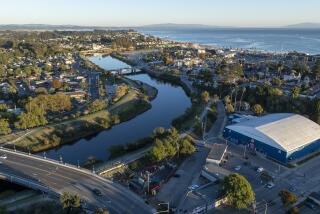Big Santa Ana Redevelopment Plan Collapses : Government: The thousands of residents who show up to protest ambitious proposal persuade council to shelve it. Mayor calls it ‘dead on arrival.’
Stunned by an unexpected crowd of about 2,000 upset residents who fear their neighborhoods will be dismantled, the City Council on Tuesday night shelved an ambitious redevelopment plan for this city’s core.
The proposal, which would designate 45% of Santa Ana as a redevelopment zone, elicited widespread fear, anger and suspicion among residents of the primarily Latino neighborhoods. Many said they fear the city will drive them from their homes.
But city officials said that much of the emotional response is a result of a misunderstanding about the real impact of the redevelopment plan, which is designed to raise money for schools and parks.
The council voted to halt the emotional meeting after hearing more than an hour of testimony from the crowd and to cancel a June 15 meeting in which the City Council was expected to vote on the proposal, so that city staff could explain it to the community.
“In my opinion, right now, this thing is dead on arrival,” Mayor Daniel H. Young said. “We need to go there on a neighborhood-by-neighborhood basis and talk.”
Under the proposal, the central 45% of Santa Ana would be designated a redevelopment area. The area--a mixture of residences and commercial establishments--is bordered roughly by Warner Avenue on the south, Euclid Street on the west, Stanford Avenue on the east and 17th Street on the north.
Santa Ana city officials stress that there are no specific development projects, and there are no current plans to seize land or homes. The project, they said, is essentially a creative way to fund schools and parks without raising taxes. Any tax revenue that results from redevelopment in that zone would be earmarked for those two causes.
Cindy Nelson, executive director of the Community Development Agency, said the area was chosen because statistics show it is among the city’s most crowded, lowest-income and highest-crime sections.
Nelson emphasized that the city redevelopment agency would not exert its power of eminent domain and force people off their private property.
But many residents remained leery. They said that Nelson was misleading them because she failed to note that other agencies--notably the City Council or school district--could use their seizure powers.
“To sit there and tell thousands of people that their homes aren’t going to go when you expand parks is a boldface lie,” Santa Ana resident Ron Heike told the council.
“The grandiose scheme in front of you really doesn’t cut it,” he added.
Councilman Ted R. Moreno said Tuesday’s meeting was poorly planned and unnecessarily alarmed residents. He said only 1% to 2% of the area eventually will be redeveloped.
“I really think that if people understood what the plan was all about, they would agree with it,” Moreno said after the meeting. “When I spoke to a few people and told them we only wanted to get rid of drug-infested apartments in gang areas, they said ‘Take them.’ ”
Despite such assurances, many residents said outside the meeting that they believe a conspiracy is underway to target a portion of the city where mostly families of Mexican descent reside.
“This is one Mexican woman not afraid to fight,” declared Ester C. Gonzalez, 64, who lives on 7th Street, where she raised her family. “I love my home and I’m not going to give it up.”
Ernest Mendez, 67, also a lifelong resident, said he fears that city officials will, little by little, take over the downtown area, moving out longtime residents who couldn’t afford to buy comparable property elsewhere.
“If they need property, there’s plenty of empty property elsewhere,” said Mendez. “Why are they taking ours?” He said he believes that some city officials are trying to take advantage of residents who cannot speak English.
Some in the large crowd said they turned out because they received a vague, confusing letter from the city.
“I got a certified letter in the mail that said, ‘Your property is in the target area.’ That sounded serious,” said Gilbert Melendez, 40.
Melendez told the council to explain the project more fully to the public, adding that many people knew too little about it. “You saw the reaction today--people said: ‘Hey you’re going to knock my house down,’ ” he said.
Added Mickie Camacho, 45, who has lived in her home for 41 years: “If they’re really worried about crime, why don’t they do something about that, not take away people’s homes.”
The crowd was so large that police tape was strung outside to keep access open to the council chambers. People packed the civic center area, lining up 20 or 30 deep to try to peek inside windows.
Many residents said they were pleased they had surprised the council with the large turnout and show of unity. City officials were clearly not expecting the public’s response to the proposed plan, Moreno said.
City Councilman Robert L. Richardson said that the project offers a way to fund new schools and parks without raising taxes.
“You potentially could take an area like near Willard Intermediate School and expand an intermediate school that was too small when it was built. We have some real tremendous needs in the town. We need to find a way for us to have parks and schools without raising taxes,” he said.
Richardson said that once residents understand what the project is designed to do, “it stands a much better chance of being successful. . . . I just think there needs to be more explanation.”
In redevelopment projects, a city defines a specific area to be improved and freezes the amount of taxes paid to the state on the property there. As the area is developed, its value increases, which brings increased tax money to the city that previously would have gone to the state. The city then uses the money for specific local purposes.
Mike Vail, a spokesman for the Santa Ana Unified School District, said the plan would provide money to fund desperately needed schools and alleviate the district’s “funding crisis.” The city staff said it could generate $38 billion over the 35-year life of the program.
Vail said most of the schools are now on year-round schedules to ease crowded classes and that the student population of 49,000 is expected to jump to 68,000 students within seven years.
Times staff writer Marla Cone contributed to this story.
More to Read
Start your day right
Sign up for Essential California for news, features and recommendations from the L.A. Times and beyond in your inbox six days a week.
You may occasionally receive promotional content from the Los Angeles Times.







